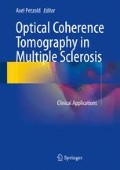Abstract
Retinal optical coherence tomography (OCT) has developed from a research tool to a validated instrument recommended for clinical use. For good clinical practice (GCP), this will require adherence to quality control (QC) criteria. This chapter will provide an overview of lessons learned from hands-on teaching of retinal OCT to a broad audience at a number of centers, both neurological and ophthalmological, and international teaching courses. The chapter will also highlight practical QC points as relevant to working together with a reading center for clinical studies and trials.
Access this chapter
Tax calculation will be finalised at checkout
Purchases are for personal use only
Notes
- 1.
ART stands for averaging of scans. The averaging algorithm takes eye movements into account. A “smoother” but not always necessarily “better” OCT B-scan will be obtained with a high ART number.
References
Frohman E, Costello F, Zivadinov R, et al. Optical coherence tomography in multiple sclerosis. Lancet Neurol. 2006;5:853–63.
Petzold A, de Boer JF, Schippling S, et al. Optical coherence tomography in multiple sclerosis: a systematic review and meta-analysis. Lancet Neurol. 2010;9:921–32.
Saidha S, Calabresi PA. Optical coherence tomography should be part of the routine monitoring of patients with multiple sclerosis: yes. Mult Scler. 2014;20:1296–8.
Costello FE. Optical coherence tomography technologies: which machine do you want to own?”. J Neuroophthalmol. 2014;34(Suppl):S3–9.
Petzold A. Optical coherence tomography to assess neurodegeneration in multiple sclerosis. Methods Mol Biol. 2014;153 ff. doi:10.1007/7651_2014_153
Tewarie P, Balk L, Costello F, Green A, Martin R, et al. The OSCAR-IB consensus criteria for retinal OCT quality assessment. PLoS One. 2012;7, e34823.
Schippling S, Balk L, Costello F, et al. Quality control for retinal OCT in multiple sclerosis: validation of the OSCAR-IB criteria. Mult Scler. 2014;21(2):163–70.
Uhthoff W. Untersuchungen über den Einfluss des chronischen Alkoholismus auf das menschliche Sehorgan. Archiv für Ophthalmologie. 1886;32:95–188.
Ogden TE. Nerve fiber layer of the primate retina: morphometric analysis. Invest Ophthalmol Vis Sci. 1984;25:19–29.
Plant GT, Perry VH. The anatomical basis of the caecocentral scotoma. New observations and a review. Brain. 1990;113(Pt 5):1441–57.
Petzold A. CSF biomarkers for improved prognostic accuracy in acute CNS disease. Neurol Res. 2007;29:691–708.
Kupersmith MJ, Anderson S, Durbin MK, Kardon RH. Scanning laser polarimetry, but not optical coherence tomography predicts permanent visual field loss in acute non-arteritic anterior ischemic optic neuropathy. Invest Ophthalmol Vis Sci. 2013;54:5514–9.
Petzold A, Wattjes MP, Costello F, et al. The investigation of acute optic neuritis: a review and proposed protocol. Nat Rev Neurol. 2014;10:447–58.
Balk LJ, de Vries–Knoppert WAEJ, Petzold A. A simple sign for recognizing off–axis OCT measurement beam placement in the context of multicentre studies. PLoS One. 2012;7(11), e48222.
Domalpally A, Danis RP, Zhang B, et al. Quality issues in interpretation of optical coherence tomograms in macular diseases. Retina. 2009;29:775–81.
Talman LS, Bisker ER, Sackel DJ, et al. Longitudinal study of vision and retinal nerve fiber layer thickness in multiple sclerosis. Ann Neurol. 2010;67:749–60.
Balk L, et al. Retinal ganglion cell injury in MS occurs most rapidly early in the course of disease. Multiple Sclerosis J. 2014;20(S1):PS8.3.
Gabriele ML, Ishikawa H, Wollstein G, et al. Optical coherence tomography scan circle location and mean retinal nerve fiber layer measurement variability. Invest Ophthalmol Vis Sci. 2008;49:2315–21.
Balasubramanian M, Bowd C, Vizzeri G, et al. Effect of image quality on tissue thickness measurements obtained with spectral domain-optical coherence tomography. Opt Express. 2009;17:4019–36.
Petzold A, Balcer L, Calabresi P, et al. OCT in a multi–centre setting: quality control issues. In: Calabresi P, Balcer L, Frohman E, editors. Optical coherence tomography in neurological disease. New York: Cambridge University Press; 2015. p. 103–13.
Evangelou N, Konz D, Esiri MM, et al. Size-selective neuronal changes in the anterior optic pathways suggest a differential susceptibility to injury in multiple sclerosis. Brain. 2001;124:1813–20.
Hariri A, Lee SY, Ruiz-Garcia H, et al. Effect of angle of incidence on macular thickness and volume measurements obtained by spectral-domain optical coherence tomography. Invest Ophthalmol Vis Sci. 2012;53:5287–91.
Hutchinson M. Optical coherence tomography should be part of the routine monitoring of patients with multiple sclerosis: commentary. Mult Scler. 2014;20:1302–3.
Author information
Authors and Affiliations
Corresponding author
Editor information
Editors and Affiliations
Electronic Supplementary Material
Below is the link to the electronic supplementary material.
Video showing correct placement of the OCT measurement beam to the center of the pupil and artifacts related to off-center placement (Reproduced with permission from Balk et al. [14].) (MP4 148502 kb)
Rights and permissions
Copyright information
© 2016 Springer International Publishing Switzerland
About this chapter
Cite this chapter
Petzold, A. (2016). Optical Coherence Tomography (OCT). In: Petzold, A. (eds) Optical Coherence Tomography in Multiple Sclerosis. Springer, Cham. https://doi.org/10.1007/978-3-319-20970-8_3
Download citation
DOI: https://doi.org/10.1007/978-3-319-20970-8_3
Publisher Name: Springer, Cham
Print ISBN: 978-3-319-20969-2
Online ISBN: 978-3-319-20970-8
eBook Packages: MedicineMedicine (R0)

